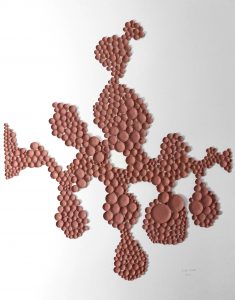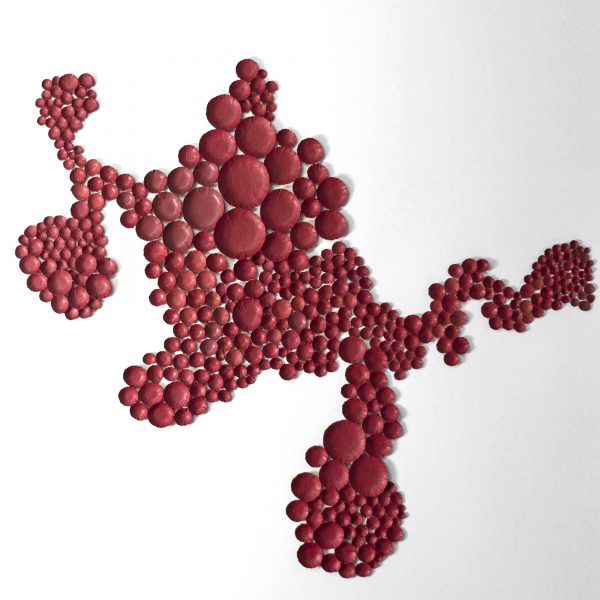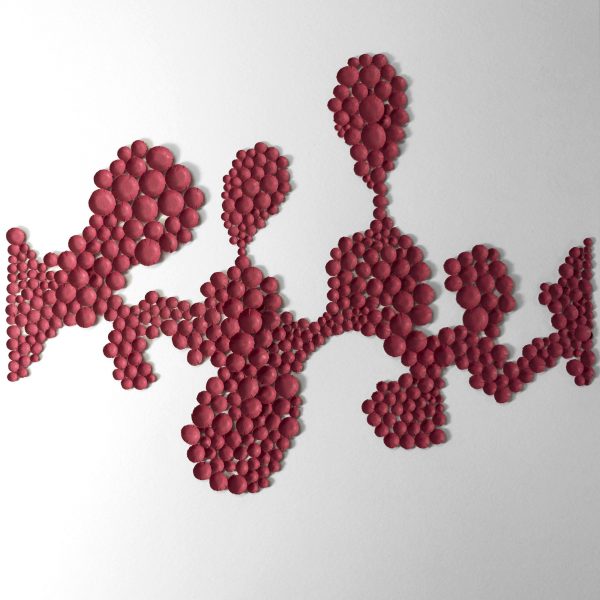…I still like to reinvent myself in everything that I do or create with my hands. The truth is that in some way each of us has the power to be what we really want to be. Isn’t that what our journey is all about?
While Elsa Mora’s oeuvre is characterized by multi-media, a recent exhibition at Jordan Schnitzer Gallery, Paper Weight, exhibited works in paper which take multifarious forms.

Taken as a group, the combined works display innumerable underlying processes to enable completion of them; her work is inspired by, the six cognitive faculties that form the mind: consciousness, perception, thinking, language, judgment, and memory.
While generally Mora’s work reflects on universal issues of identity, connectivity, and survival, the artist has a special connection to mental health,
the fact that some members of my family suffer from mental illnesses made me want to understand the mysteries of an organ that rules a great part of human behaviour.
As a consequence the twin foci of paper’s potential and the potential of the mind have come to characterise Mora’s oeuvre, for example Fading is a work about consciousness
… (the quality of being aware)… The gradation of colors is a visual representation of that state of appearing and disappearing.
Academically, consciousness refers to [the] individual awareness of…unique thoughts, memories, feelings, sensations, and environment. In lay man’s terms consciousness is the initial subjective experience of the world through the senses.
An idea came to mind that consciousness could be seen as a collection of small containers carrying everything that we know .
 Fading as a group is a type of physical continuum, in which the series fades from deep red to white. Conceptually, however, there are other ways it can be considered, for example, it is possible to view the fading from red to white as the broad transition from known information to unknown information and back again on a continuum. The series goes from deep red with associative connotations, to white to indicate an absence of information of empty containers.
Fading as a group is a type of physical continuum, in which the series fades from deep red to white. Conceptually, however, there are other ways it can be considered, for example, it is possible to view the fading from red to white as the broad transition from known information to unknown information and back again on a continuum. The series goes from deep red with associative connotations, to white to indicate an absence of information of empty containers.
Furthermore, endemic to the Fading series are the individual containers in different sizes and although the series fades from red to white, each of the works extend randomly outward in different directions by virtue of the containers.
Contiguously, the fading of red to white could also define Mora’s practice as an artist and a desire to move from what she knows in relation to the work she has produced over the preceding decades into the exploration of areas in her art practice she is yet to discover.
 In other words, the artist begins from a state of knowledge (red zone), advances that knowledge creatively to include new research into other aspects of practice and process (pale pink areas). The artist fuses existing knowledge with fresh ideas proceeding to ultimately imprint an open and receptive field of nascent consciousness (white zone). The final manifestation now places the artist back in the dense red of heightened consciousness.
In other words, the artist begins from a state of knowledge (red zone), advances that knowledge creatively to include new research into other aspects of practice and process (pale pink areas). The artist fuses existing knowledge with fresh ideas proceeding to ultimately imprint an open and receptive field of nascent consciousness (white zone). The final manifestation now places the artist back in the dense red of heightened consciousness.
Similarly, The containers which carry everything we know change, shift and relocate in relation to the new knowledge taken up, as does the notion of consciousness itself.
It isn’t surprising to me that given a new tool of observation, the prepared mind of the scientists will make serendipitous discoveries.
The above discussion and quote relates also to practice in scientific research. For example, Einstein’s theories were worked upon thoroughly throughout the 20th and 21st centuries resulting in findings by other scientists; to name just two, the process of thermal heat transfer in 2018 and solar power.
Likewise, the history of science generally is littered with serendipitous discoveries, Fleming and Penicillin, and Spencer’s microwave to name just two. No doubt in the life of Jonathan Edwards (Emeritus Professor of Connective Tissue Medicine at University College London), a lifetime of dedication to research in medicine prepared his mind for a breakthrough discovery in 2005 at University College London when he was able to contend that
Since it is unlikely that one specific neurone is conscious, it is suggested that every neurone has a version of our consciousness, or at least some form of sentience…In the future, Edwards suggests that his theory may help to explain…more accurately…many of the ambiguities associated with mental illness.
The concept of the prepared mind of the scientist, is one which applies equally to the artist,

The cups or containers in Fading are reminiscent of small cells of inter-connected but discrete knowledge spreading out in ever-expanding branches, arbitrarily because, by implication, the directions and nuances of information and interpretation are endless.
While there are too many analogies to consider here, both the prepared mind of the artist and scientist have the ability to change the direction and impetus of research, change the position and direction of the containers to bring about new ends as well as provide fertile ground for still more serendipitous findings. Consequentially, the pure white field, open and amenable, is filled with both existing and primary knowledge driven by the creative mind of the artist or scientist.
The relationship of the artist to both serendipity and the prepared mind is revealing when the range of processes and concepts inherent to Mora’s practice is examined.
 Although the artist does not specifically mention serendipity in her practice, one has only to look at both the body of work in paper and ceramics to see that the multitude of processes and diverse forms embrace the concept of serendipity.
Although the artist does not specifically mention serendipity in her practice, one has only to look at both the body of work in paper and ceramics to see that the multitude of processes and diverse forms embrace the concept of serendipity.
The idea of serendipity is important because the unexpected discovery in the midst of a planned discovery might just be even more substantial than what we were looking for in the first place.
Similarly, serendipity and creative approaches in both art and science are important to the discovery of knowledge or the raising of consciousness. Hence, a reading of Fading as everything we know characterised by the deep dense red transitioning to immaculate white as knowledge yet to be discovered, or unknown fields of knowledge in waiting.
Extrapolating, the concept can be considered personally or at a national or global level, for example what Edwards discovered above raises the level of consciousness in the field of neuropsychology and neuroscience specifically but the medical profession generally. What we know of the world tells us that there is much more of the world we know nothing about; the known and the unknown, two sides of the same coin, inextricably linked; an idea Mora considers in more detail in One Hundred and One Notions.
For the last few years, I have been fascinated by the expressive quality of paper, an unassuming material that I see as a metaphor for transformation and reinvention.
Elsa Mora’s art has been exhibited worldwide in art galleries and museums. She taught at the Vocational School of Arts in Camagüey, Cuba, and has been a visiting artist at the Art Institute of Chicago, San Francisco State University, the Art Institute of Boston, the MoMA Design Store, and the National Gallery of Art, among others.
Mora is one of the founding members of ArtYard, a contemporary art center based in Frenchtown, New Jersey, where she is artistic director and curator.
Unless otherwise stated all quotes in italics are by Elsa Mora.






































